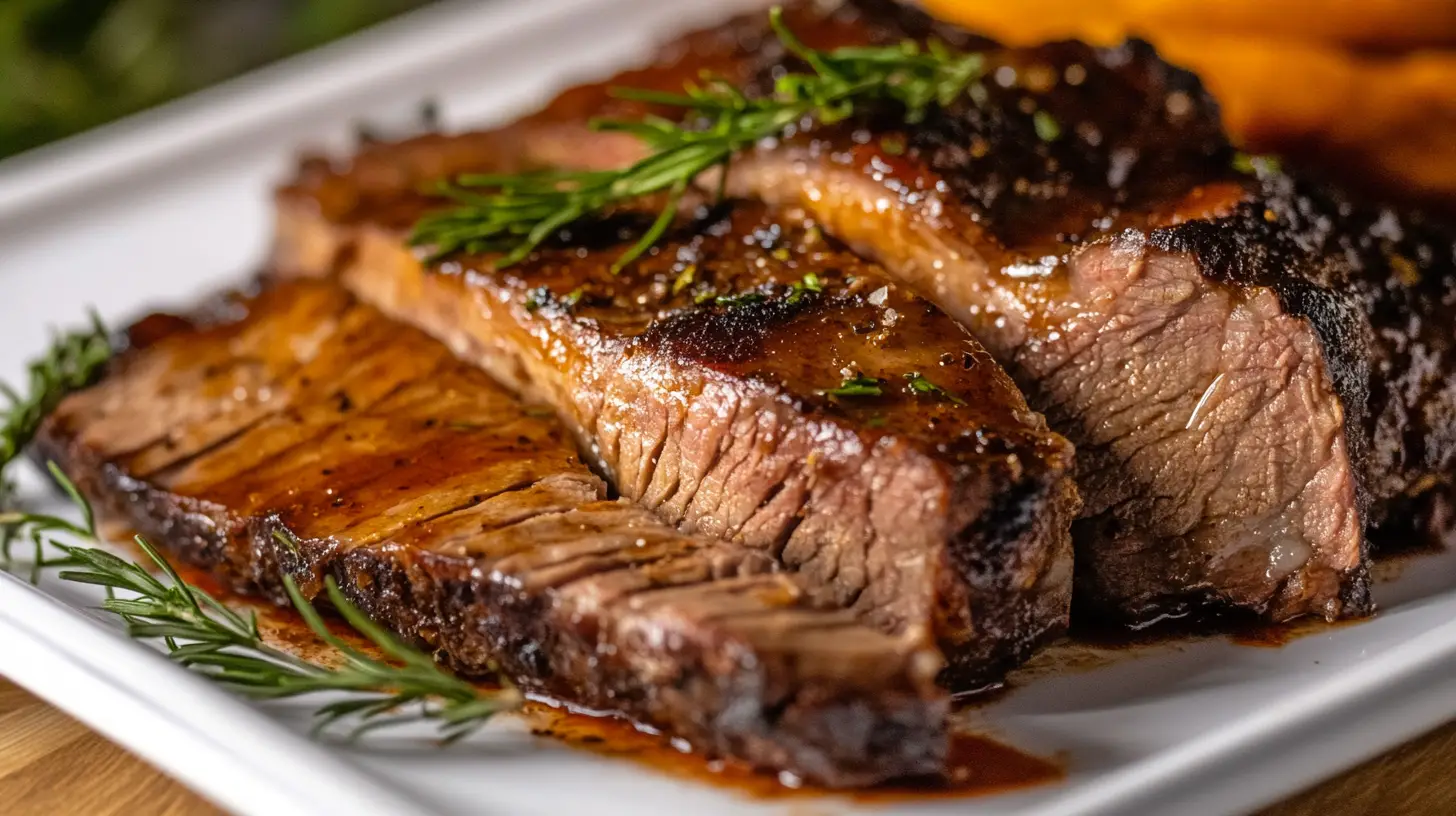Table of Contents
Few things in the world of barbecue rival the deep, smoky flavor of hickory smoked meats. That rich, slightly sweet, bacon-like aroma, combined with the perfect low and slow cooking method, creates BBQ magic that keeps people coming back for more.
Whether you’re a seasoned pitmaster or just getting started with smoking meats, this guide will walk you through everything you need to know—from choosing the best smoker and wood to perfecting the smoke ring and bark. And if you’re looking for the perfect sauce pairing, don’t miss this Carolina Gold BBQ Sauce for a tangy kick that complements hickory’s boldness.
Introduction
The Allure of Hickory Smoked BBQ
Hickory is a go-to smoking wood for BBQ lovers, thanks to its:
✔️ Bold, smoky taste that enhances sheep, beef, and poultry.
✔️ Beautiful mahogany color that forms a rich, flavorful bark.
✔️ Versatility—it pairs well with other woods like oak, cherry, and apple.
Hickory’s ability to add depth and complexity to meats makes it an essential wood choice for any serious smoker.
Understanding Hickory Smoking
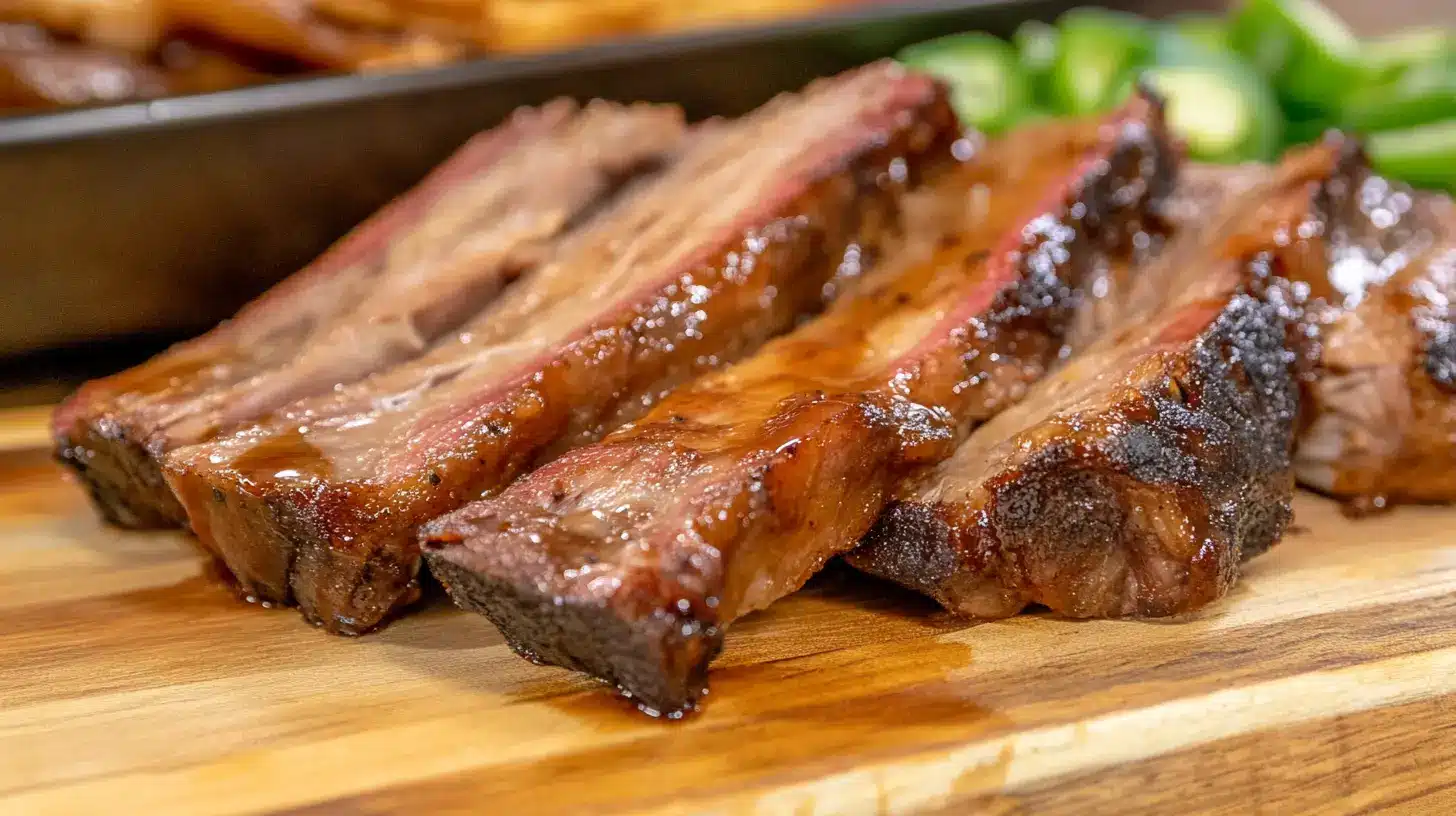
Why Hickory?
Hickory strikes the perfect balance between mild fruitwoods and strong hardwoods like mesquite. It burns hot and clean, making it a favorite for long smoking sessions.
The Science Behind Smoking
- Smoke penetrates the meat, enhancing its natural flavors.
- The Maillard reaction creates that rich, caramelized crust (bark).
- Collagen breakdown results in fall-apart tenderness.
Want to explore other smoky flavors? Try experimenting with Pellet Smoker Recipes to find the perfect wood combination for your next BBQ.
Essential Equipment for Hickory Smoking
Choosing the Right Smoker
Your choice of smoker directly impacts the depth of flavor. Here’s a breakdown:
- Offset Smokers – Traditional wood-burning flavor, ideal for large cuts.
- Pellet Grills – Great for precision temperature control with real wood smoke.
- Charcoal Smokers – Authentic smokiness, best when combined with wood chunks.
Must-Have Tools and Accessories
✔️ Meat thermometer – Ensures your meat reaches perfect doneness.
✔️ Water pan – Keeps meat moist during long smoking sessions.
✔️ Heat-resistant gloves – Essential for handling hot grates and logs.
Selecting the Best Meats
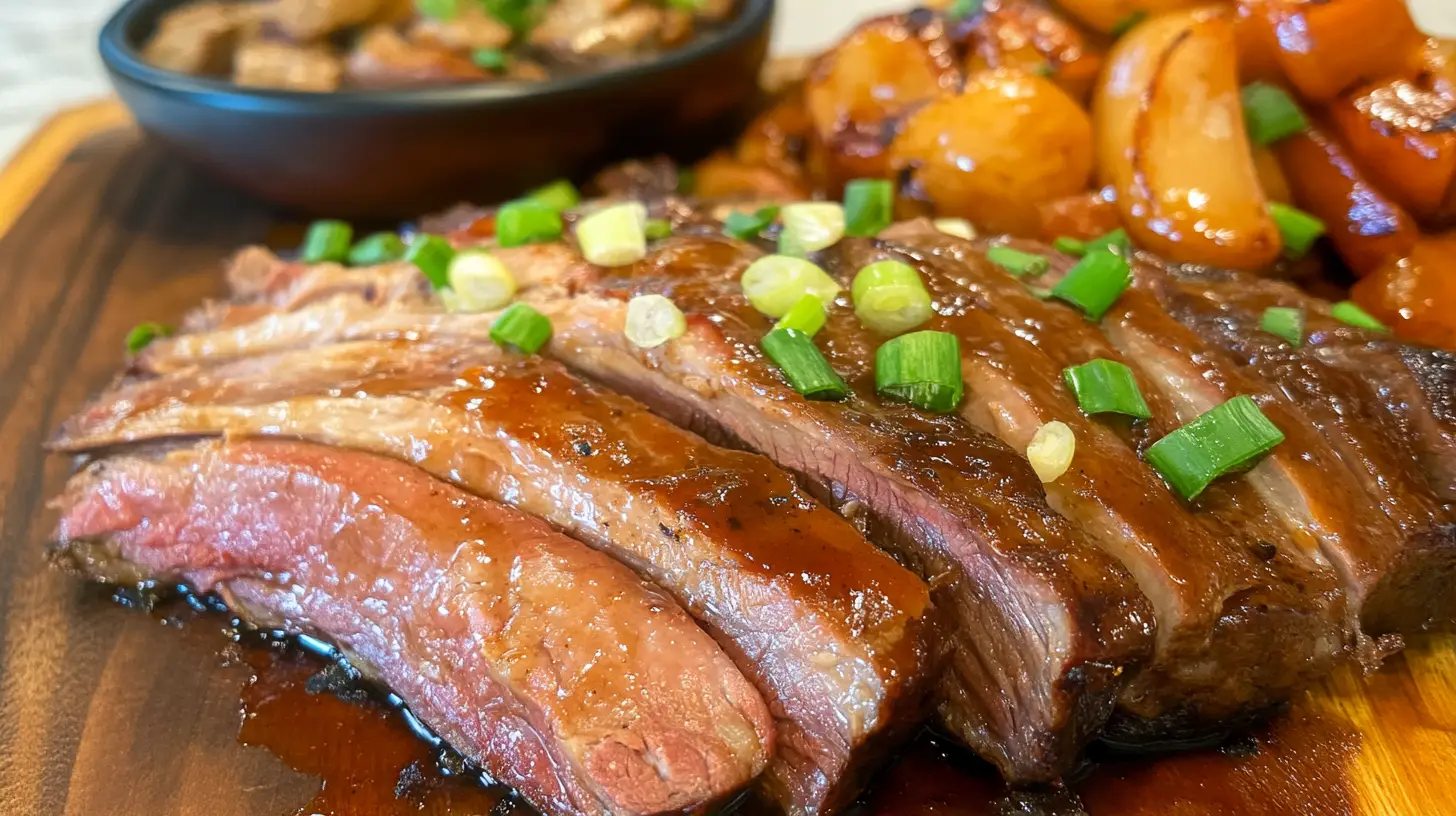
Beef Cuts for Smoking
- Brisket – The ultimate BBQ challenge, requiring 10-12 hours of slow smoking.
- Short Ribs – A meaty, flavorful cut that absorbs hickory smoked beautifully.
Poultry and Seafood Options
- Whole Chicken & Turkey – Soaks up hickory’s deep smokiness beautifully.
- Salmon & Trout – The sweet-smoky contrast makes for a gourmet BBQ experience.
Want the perfect sauce pairing? This 3-Ingredient BBQ Sauce is a simple yet flavorful option for smoked meats.
The Perfect Hickory Wood Selection
Types of Hickory Wood
- Shagbark Hickory – The strongest hickory smoked, best for sheep and beef.
- Pecan Hickory – A sweeter, milder option, great for poultry and seafood.
How to Prepare Wood for Smoking
- Use dry, seasoned hickory for clean-burning smoke.
- Avoid soaking wood—it creates steam, not smoke.
Want to add extra complexity to your smoke? Pair hickory with oak orfruitwoods for a balanced smoky depth.
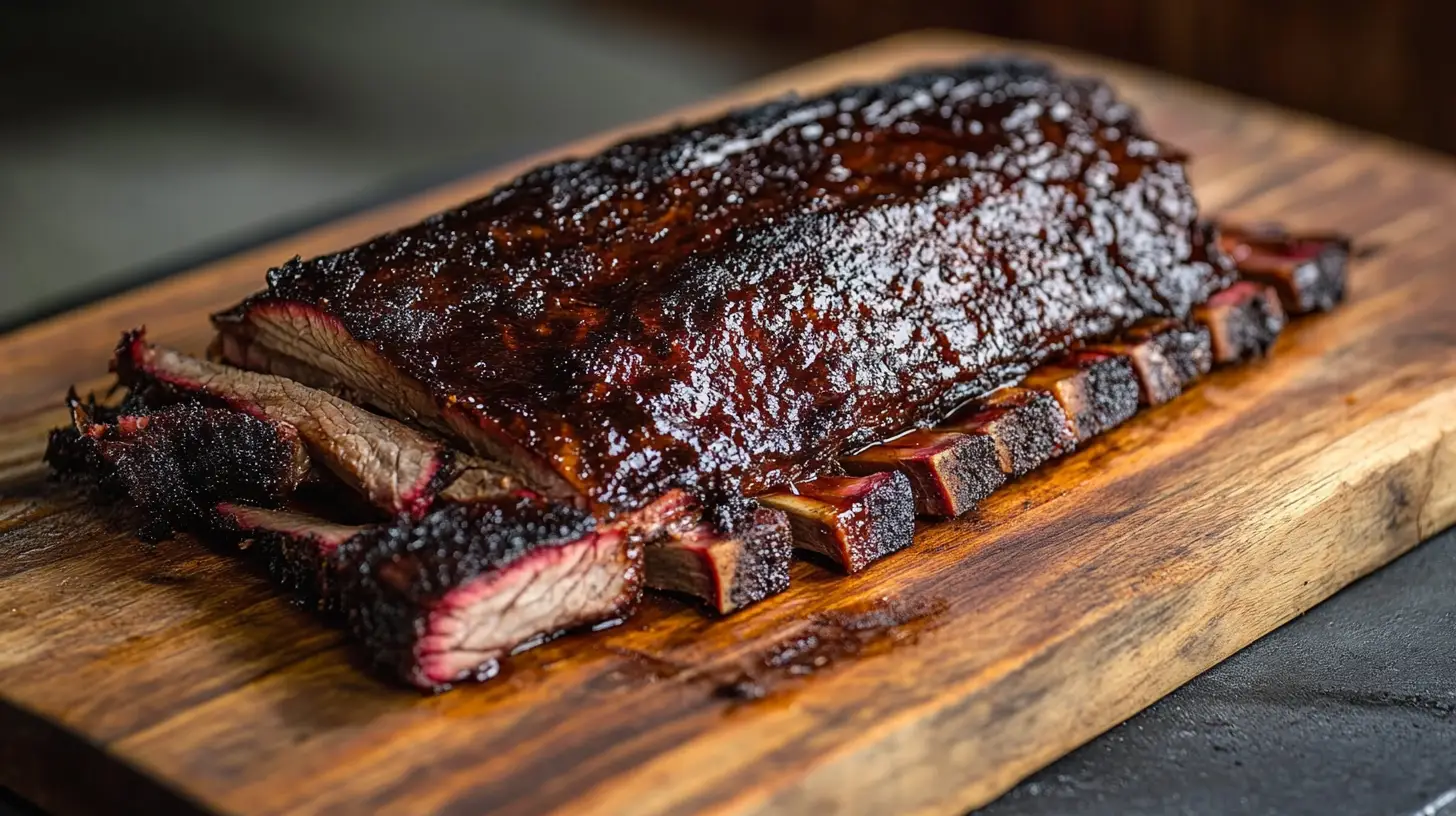
The Smoking Process: Step-by-Step
Perfecting the hickory smoking process is both an art and a science. The goal is to infuse your meat with a rich, smoky flavor while maintaining a juicy, tender texture. To achieve this, it’s essential to follow a structured approach that ensures proper preparation, consistent temperature control, and optimal smoke levels. Below is a detailed, step-by-step guide to mastering the hickory smoking process.
1. Preparing Your Smoker
Before placing your meat in the smoker, you need to ensure that your equipment is properly set up. Different smokers require slightly different setups, but the fundamentals remain the same.
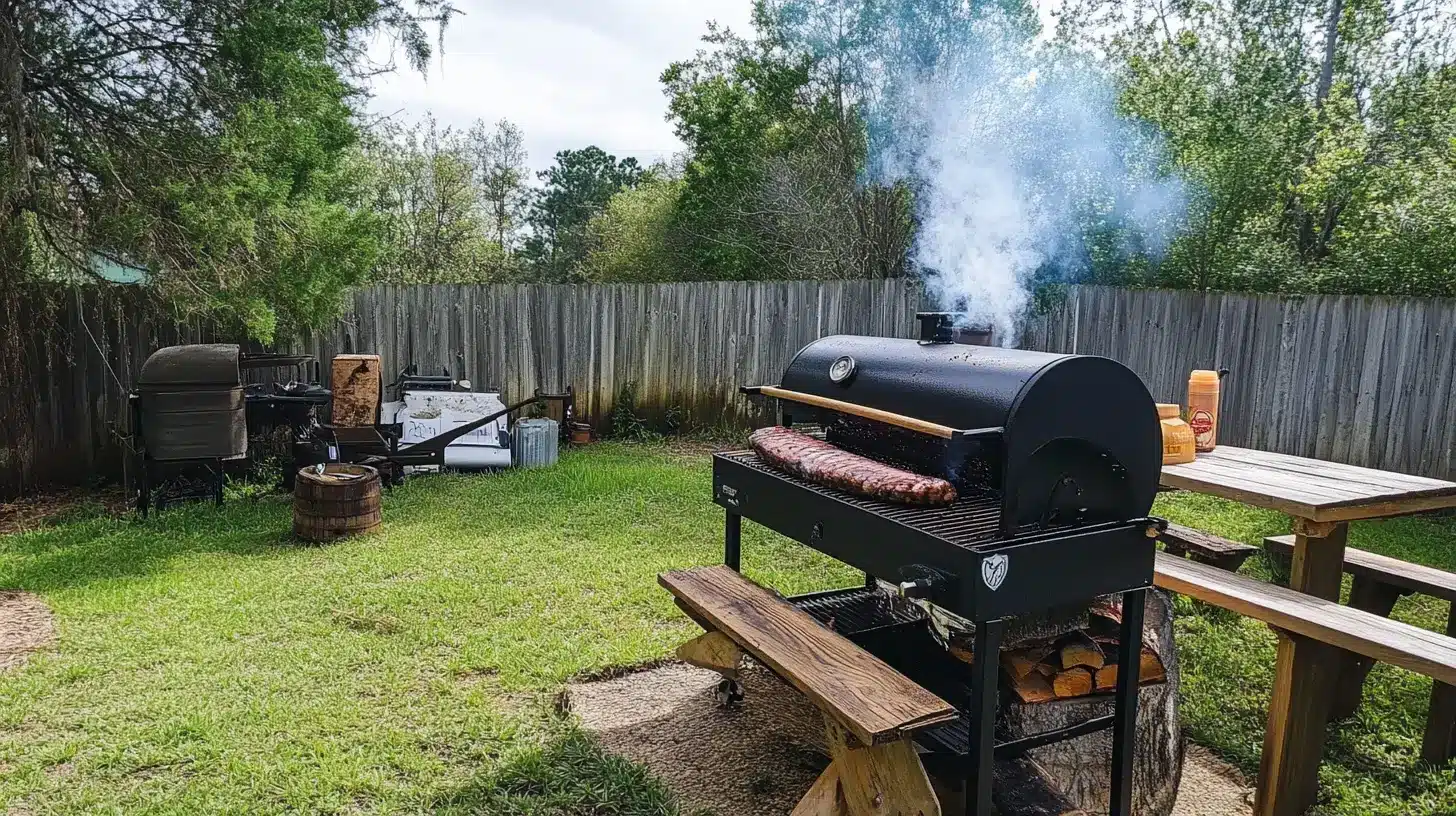
Step 1: Choose the Right Fuel & Wood
- If using a charcoal smoker, start with lump charcoal or briquettes as your primary heat source. Add hickory wood chunks or logs to generate smoke.
- For pellet grills, fill the hopper with hickory pellets, which provide a steady release of smoke.
- With an offset smoker, burn split hickory logs in the firebox for an authentic wood-fired experience.
- Gas or electric smokers can benefit from hickory wood chips placed in a smoker box or tray to enhance flavor.
Step 2: Preheat Your Smoker
- Set your smoker’s temperature to 225-250°F (107-121°C)—the ideal range for low and slow cooking.
- Allow at least 15-30 minutes for the smoker to stabilize at the desired temperature.
Step 3: Manage Airflow and Ventilation
- Keep air vents slightly open to maintain clean combustion. Proper airflow ensures thin, blue smoke, which delivers the best flavor.
- If thick white smoke is billowing from your smoker, adjust the vents or add more airflow to prevent bitter, acrid flavors.
2. Maintaining Temperature and Smoke Levels
The key to flavorful, perfectly smoked BBQ is maintaining a consistent temperature and smoke output. Here’s how to do it:
Step 4: Use a Water Pan for Moisture Control
- Placing a water pan inside the smoker helps regulate heat and prevents meat from drying out.
- This is especially important for long cooks like brisket and beef shoulder.
Step 5: Monitor the Smoke
- Aim for a thin, light blue smoke—this is the sweet spot for clean, flavorful smoking.
- Avoid thick, billowing white smoke, as it can leave a harsh, sooty taste on the meat.
Step 6: Add Hickory Wood in Moderation
- Too much hickory smoke can overpower the meat and cause bitterness.
- Add small amounts of hickory wood every 45-60 minutes to maintain a steady, controlled smoke level.
- For a more balanced smoke profile, mix hickory with oak or fruitwoods like cherry or apple.
Pro Tip: If your smoker has a built-in thermometer, double-check accuracy with a calibrated digital thermometer to ensure precise temperature readings.
3. Smoking the Meat
Now that your smoker is ready, it’s time to get the meat inside and start the magic!
Step 7: Place the Meat in the Smoker
- Position meats away from direct heat to allow for even cooking.
- Larger cuts like brisket and beef shoulder should go on the lower racks, while ribs and poultry work best on upper racks where they receive steady, indirect heat.
Step 8: Close the Lid & Let the Smoke Work
- Resist the urge to check the meat too often! Every time you open the smoker, heat escapes, causing temperature fluctuations.
- Check on the meat only when necessary, typically every 1-2 hours to spritz or rotate.
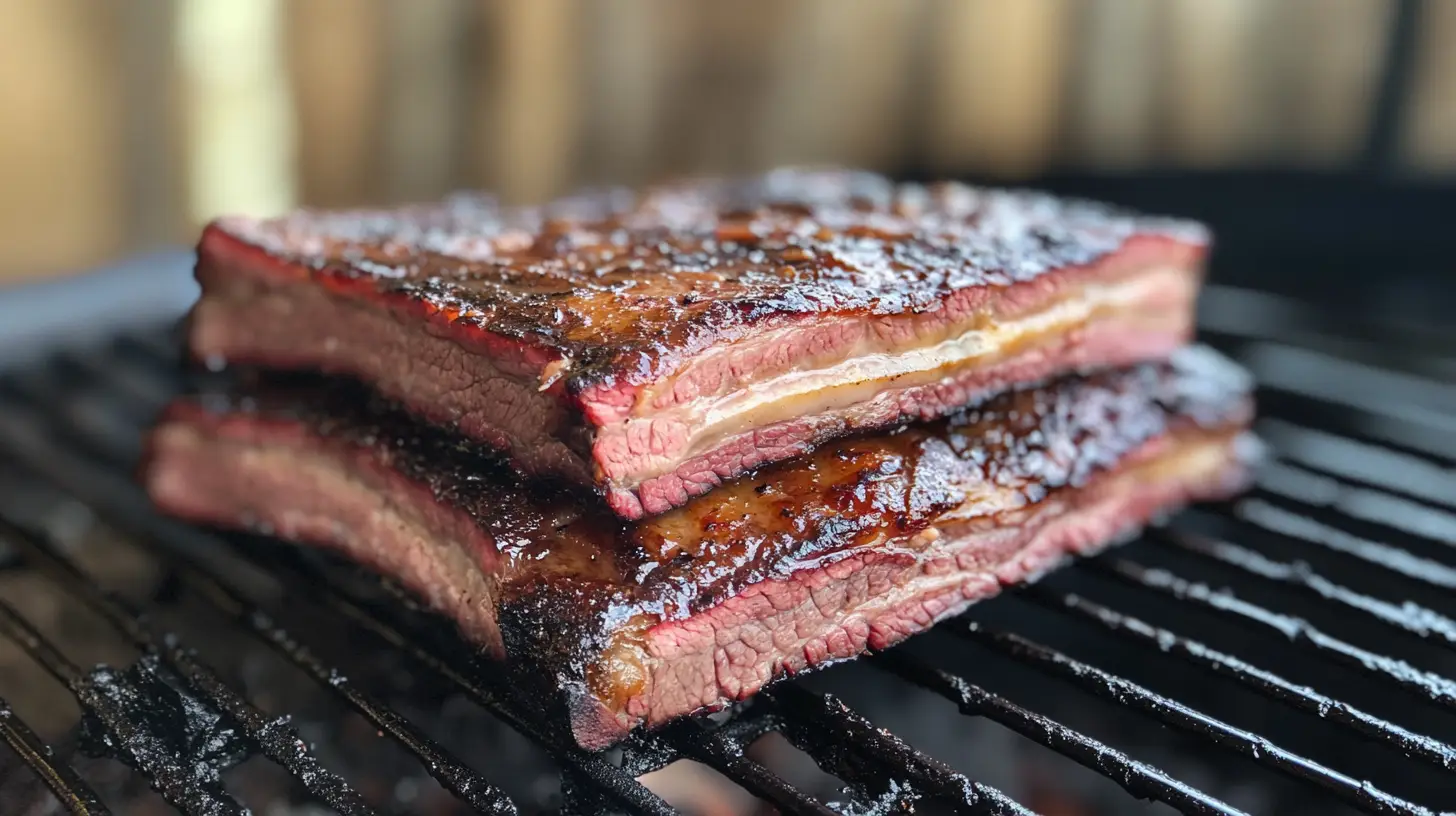
4. Monitoring and Adjusting During the Cook
Even with the best setup, adjustments are sometimes necessary to ensure everything goes smoothly.
Step 9: Spritz or Mop for Extra Moisture (Optional)
- To keep the meat moist and develop a flavorful bark, lightly spritz with apple cider vinegar, apple juice, or a butter-based mop sauce every hour after the first 2-3 hours of smoking.
Step 10: Wrap the Meat (Texas Crutch Method – Optional)
- Wrapping meat in butcher paper or aluminum foil can help speed up the cooking process and retain moisture.
- This is particularly useful for brisket and beef shoulder when they hit the infamous stall (around 160°F / 71°C).
- If wrapping, reintroduce the meat to the smoker and let it finish cooking until it reaches the desired internal temperature.
5. Knowing When the Meat is Done
Every cut of meat has an ideal internal temperature to achieve tender, juicy perfection. Always use a high-quality meat thermometer to check doneness.
Step 11: Check Internal Temperatures
- Brisket: 203°F (95°C) – Tender and juicy, probe should slide in effortlessly.
- Pulled beef (beef Shoulder/Boston Butt): 195°F (90°C) – Shreds easily.
- Ribs: 190-205°F (88-96°C) – Bones should pull away easily.
- Chicken & Turkey: 165°F (74°C) – Juicy and safe to eat.
6. Resting & Serving for Maximum Flavor
Step 12: Rest the Meat Before Slicing
- Once removed from the smoker, let the meat rest for at least 30-60 minutes. This allows juices to redistribute, preventing them from escaping when sliced.
- Brisket and beef shoulder benefit from longer resting times—up to 2 hours if wrapped in butcher paper and placed in a cooler.
Step 13: Slice & Serve the Right Way
- Brisket: Slice against the grain for tenderness.
- Pulled beef: Use bear claws or forks to shred the meat.
- Ribs: Cut between bones for perfectly portioned servings.
Pro Tip: Pair your smoked meats with homemade sauces for extra flavor. Try this Chipotle BBQ Sauce for a smoky, spicy twist!
The key to great BBQ isn’t just the wood or the smoker—it’s about patience, precision, and passion. By following this step-by-step process, you can achieve perfectly smoked, mouthwatering meats every time.
So fire up your smoker, get the hickory wood ready, and enjoy the incredible flavors that only low and slow smoking can deliver! 🔥🍖
Would you like recommendations for the best side dishes to serve with your smoked meats? Let me know! 😊
Brining and Marinating for Maximum Flavor
Essential Marinades and Rubs
A well-seasoned meat enhances hickory’s signature flavor.
✔️ Dry Rub: Salt, black pepper, paprika, garlic powder, brown sugar.
✔️ Savory Marinade: Apple cider vinegar, mustard, Worcestershire sauce.
Dry Rub vs. Wet Marinade
- Dry rubs create a crispy bark and deeper smoke penetration.
- Marinades infuse meat with extra moisture and tenderness.
The Low and Slow Cooking Technique
The Ideal Temperature for Smoking
- Brisket & beef Shoulder: 225-250°F (8-12 hours).
- Ribs: 225°F (5-6 hours).
- Chicken & Turkey: 275°F (2-4 hours).
How Long Should You Smoke Different Meats?
- Brisket: 10-12 hours (internal temp 203°F).
- Chicken & Turkey: 2-4 hours (internal temp 165°F).
Achieving the Perfect Bark and Smoke Ring
What is the Smoke Ring?
The pink layer beneath the bark is created when smoke reacts with meat proteins.
Creating a Flavorful Bark
- Use coarse salt and pepper for texture.
- Let meat rest before slicing to lock in juices.
Common Mistakes to Avoid
Overpowering with Smoke
Too much hickory Smoked can make BBQ bitter—use a balanced approach.
Not Controlling Temperature Properly
- Fluctuations cause tough meat—keep temperatures steady.
- Use a thermometer to monitor internal temps accurately.
Best BBQ Sauces for Hickory Smoked Meats
1. Classic BBQ Sauce Styles for Hickory Smoked Meats
There are several regional BBQ sauce styles, each with its own unique flavor profile. Choosing the right one depends on personal preference and the type of meat you’re serving.
1.1. Kansas City-Style BBQ Sauce (Sweet & Smoky)
- Flavor Profile: Thick, tomato-based, sweet with a smoky depth.
- Main Ingredients: Ketchup, molasses, brown sugar, vinegar, Worcestershire sauce, and spices.
- Best Paired With: Beef brisket, ribs, pulled beef
Want to keep it simple? Try this 3-Ingredient BBQ Sauce—a quick and delicious option that pairs well with hickory smoked ribs or pulled beef
1.2. Carolina Gold BBQ Sauce (Tangy & Mustard-Based)
- Flavor Profile: Tangy, slightly sweet, with a peppery finish.
- Main Ingredients: Yellow mustard, apple cider vinegar, honey, black pepper, Worcestershire sauce.
- Best Paired With: Pulled beef, beef ribs, smoked chicken.
Looking for a tangy contrast to hickory smoked? Check out this Carolina Gold BBQ Sauce—perfect for drizzling over beef shoulder or ribs.
1.3. Texas-Style BBQ Sauce (Bold & Peppery)
- Flavor Profile: Less sweet, more savory and spicy, with a bold, smoky heat.
- Main Ingredients: Tomato paste, Worcestershire sauce, black pepper, garlic, chili powder.
- Best Paired With: Beef brisket, short ribs, smoked sausage.
Do you love smoky heat? Try adding a spicy kick with this Chipotle BBQ Sauce—a great option for hickory smoked ribs or brisket.
1.4. Memphis-Style BBQ Sauce (Vinegary & Slightly Spicy)
- Flavor Profile: Tangy, with a mild heat and thinner consistency.
- Main Ingredients: Tomato sauce, vinegar, black pepper, cayenne, brown sugar.
- Best Paired With: beef ribs, pulled beef, smoked turkey.
2. Best Homemade BBQ Sauce Recipes for Hickory Smoked Meats
If you prefer homemade BBQ sauces, making your own allows you to customize flavors and perfect the balance of sweetness, tang, and smokiness.
2.1. Classic Hickory Smoked BBQ Sauce Recipe
This sauce is rich, sweet, and smoky—a perfect match for hickory smoked meats.
Ingredients:
✔️ 2 cups ketchup
✔️ ½ cup apple cider vinegar
✔️ ½ cup brown sugar
✔️ ¼ cup molasses
✔️ 1 tbsp Worcestershire sauce
✔️ 1 tsp smoked paprika
✔️ 1 tsp garlic powder
✔️ 1 tsp onion powder
✔️ ½ tsp cayenne pepper (optional, for a little heat)
Instructions:
1️⃣ Combine all ingredients in a saucepan over medium heat.
2️⃣ Stir well and bring to a gentle simmer.
3️⃣ Cook for 10-15 minutes, stirring occasionally, until the sauce thickens.
4️⃣ Remove from heat and let cool before using.
- Best Paired With: Ribs, pulled beef, brisket.
2.2. Spicy Hickory BBQ Sauce Recipe
If you enjoy a kick of heat, this spicy BBQ sauce adds depth and intensity to your smoked meats.
Ingredients:
✔️ 2 cups tomato sauce
✔️ ¼ cup apple cider vinegar
✔️ ¼ cup honey or maple syrup
✔️ 2 tbsp Worcestershire sauce
✔️ 1 tbsp chipotle peppers in adobo sauce (finely chopped)
✔️ 1 tsp smoked paprika
✔️ 1 tsp black pepper
✔️ ½ tsp cayenne pepper
Instructions:
1️⃣ Heat all ingredients in a saucepan over medium heat.
2️⃣ Stir well and let the sauce simmer for 15 minutes, allowing flavors to meld.
3️⃣ Cool before serving or storing.
- Best Paired With: Brisket, ribs, smoked turkey.
3. Pairing the Right BBQ Sauce with Hickory Smoked Meats
Each sauce works best with specific types of smoked meats. Below is a quick guide to matching flavors for the best results.
3.1. Best BBQ Sauce for Brisket
✔️ Texas-Style BBQ Sauce (Bold & peppery)
✔️ Chipotle BBQ Sauce (Smoky with a hint of spice)
- Pro Tip: Hickory’s bold smoke pairs well with savory, slightly spicy sauces that enhance the meaty richness of brisket.
3.2. Best BBQ Sauce for Ribs
✔️ Kansas City-Style BBQ Sauce (Sweet & smoky)
✔️ Classic Hickory BBQ Sauce (Balanced & flavorful)
- Pro Tip: Ribs benefit from thicker, sweeter sauces that caramelize beautifully when applied in the last 30 minutes of smoking.
3.3. Best BBQ Sauce for Smoked Chicken & Turkey
✔️ Alabama White Sauce (Tangy & creamy)
✔️ Pecan Hickory BBQ Sauce (Nutty & slightly sweet)
- Pro Tip: Poultry pairs well with lighter, tangy sauces that enhance the subtle smokiness.
Serving and Presentation Tips
Best Side Dishes for Smoked BBQ
✔️ Mac and cheese
✔️ Coleslaw
✔️ Baked beans
How to Slice and Serve Smoked Meat
- Slice brisket against the grain for tenderness.
- Rest beef shoulder before shredding to retain juices.
Frequently Asked Questions about Hickory Smoked BBQ
What is Hickory Smoked BBQ Flavor?
Hickory smoked BBQ flavor is rich, bold, and slightly sweet, with a distinct smoky depth that enhances meats like beef, beef, and poultry. The wood’s natural oils and sugars create a bacon-like aroma, giving the meat a savory, well-rounded taste. Compared to fruitwoods like apple or cherry, hickory delivers a stronger, more pronounced smokiness that is both earthy and slightly sweet, making it a favorite in Southern-style BBQ.
How Spicy is Wingstop Hickory Smoked BBQ?
Wingstop’s Hickory Smoked BBQ flavor is not spicy at all—it is more sweet and smoky with a mild tanginess. The sauce is crafted to highlight the deep smokiness of hickory wood, balanced with molasses-like sweetness and subtle savory undertones. If you’re looking for heat, this flavor may not be the best choice, but it pairs wonderfully with spicier options like Atomic or Mango Habanero for a contrast in flavors.
What Does Hickory Barbecue Taste Like?
Hickory barbecue has a bold, smoky taste with a slightly sweet, nutty undertone. The flavor profile is often described as deep, robust, and woodsy, with hints of bacon-like richness. When used to smoke meats, hickory imparts a hearty, slightly sweet, and earthy flavor that enhances both dry rubs and barbecue sauces. It is stronger than apple or cherry wood but not as intense or bitter as mesquite.
Is Hickory Smoked BBQ Sauce Sweet?
Yes, most hickory smoked BBQ sauces have a sweet component, often derived from ingredients like brown sugar, molasses, or honey. However, the dominant flavor comes from the smoky, slightly tangy notes of hickory. Some variations include spicy or tangy elements, but traditional hickory smoked BBQ sauce leans more toward sweet and smoky rather than hot or acidic. If you prefer a balance of sweetness and heat, consider trying a chipotle-infused hickory BBQ sauce for a smoky kick.
Final Thoughts
Mastering hickory smoked BBQ takes patience, precision, and passion. Whether you’re perfecting your brisket bark or experimenting with different wood pairings, every smoke session brings you closer to BBQ perfection.
🔥 Fire up your smoker and let the smoke work its magic! 🔥

